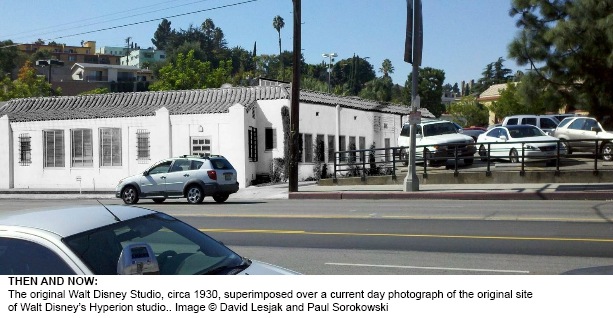2719 Hyperion Avenue — the one location in Disney history that remains a constant fascination for many Disney fans.
Eighty-seven years ago today, on July 6, 1925, Walt and Roy Disney made a $400 down payment on Lot 21, Block 18, in the Ivanhoe Track of Los Feliz on the eastern reaches of Hollywood. At the time vacant, dusty lots dominated the neighborhood — a photograph taken in 1925 shows just a scattering of new residences and even fewer businesses.

A final $600 payment in August completed the purchase, and by mid-January 1926 construction had begun on a simple 32 by 38 foot wood-frame building. The main features of the new studio included two small offices (one each for Walt and Roy), a camera room, and a large partitioned work area with animators on one side and ink and paint staff on the other. The studio was assigned what would later become an iconic address: 2719 Hyperion Avenue.
As Walt’s dreams grew larger in scope, the studio’s physical plant strained to keep pace with the influx of new staff. Over a four year period the original building underwent five major additions and numerous renovations. As staff outgrew that space a two-storey structure known as “Animator’s Building No. 1” and a sound stage were added in the spring of 1931. Other major construction projects on surrounding lots included a “Shorts Building” in 1934, separate Ink and Paint and Annex buildings in 1935, and a “Features Building” in 1937.
Besides the larger construction projects many smaller structures were built between 1932 and 1939 including a bungalow, warehouse, monitor room, and film and storage vaults. Buildings were also added to house scene planning, the library, pre-scoring, the organ, and the background and camera departments. At one point in time there was even a garage for Mickey’s private car.
By 1939, studio buildings occupied a block-long stretch of Hyperion between Griffith Park Boulevard to the west and Monon Street to the east. When every square foot of property that could be built on had been built on, staff were stuffed into nearby apartment buildings and shacks in the surrounding neighborhood — even the former Harmon-Ising cartoon studio on Seward Street was leased to house staff working on Bambi.
Hyperion holds a special place in animation history. It was the location where Walt Disney and his staff experimented with sound, color, and new camera techniques; where pencil tests were previewed in the sweatbox; where storyboards were incorporated into the production process; where personality animation was explored and developed; and where Walt Disney invested both time and money training his staff.

Hyperion bore witness to Walt Disney’s ascension as the head of the most successful cartoon studio ever established. Over time, Hyperion became the location where the ideas for the majority of Walt Disney’s “golden-age” accomplishments were spawned, nurtured, and brought to life by a myriad of talented men and women, and while conditions were crowded, the feeling of camaraderie was high, the exchange of ideas flowed freely, and creativity knew no boundaries.
Several years after leaving Hyperion for his state-of-the-art studio in Burbank, Walt Disney commented on the accomplishments that had been attained at Hyperion: “Each year we would handle a wider range of story material [and] attempt things we could not have dreamed of tackling the year before. The span of twelve years between Steamboat Willie, the first Mickey with sound, and Fantasia, is the bridge between primitive and modern animated pictures. No genius built this bridge. It was built by hard work and enthusiasm, integrity of purpose, a devotion to our medium, confidence in its future, and, above all, by steady day-to-day growth in which we all simply studied our trade and learned.”

Today, the only building in the neighborhood to have been used by Disney staff is one small bungalow that still stands on Griffith Park Boulevard. With the exception of several buildings that were relocated to the Burbank property in 1940, every other building associated with Walt Disney’s Hyperion studio was bulldozed into oblivion in the fall of 1966. Ironically, Walt Disney himself passed away just four months after the destruction of the remaining Hyperion buildings.
Little did Walt and Roy know at the time, but their small studio built on the initial plot of land bought in 1925 would become the foundation of an empire that now employees tens of thousands around the world and brings joy to countless more.
David Lesjak is a Disney historian who has been researching and writing about the history and creative legacy of Walt Disney for 25 years. David collects 1930s Disney memorabilia and Disney World War II items. David has been a Consultant, Special Projects, to The Walt Disney Family Museum and he currently leads a team of four researchers documenting the history of Walt Disney’s Hyperion Avenue studio.
